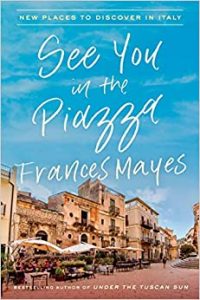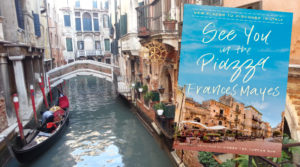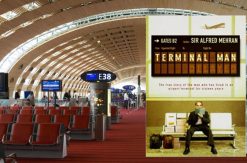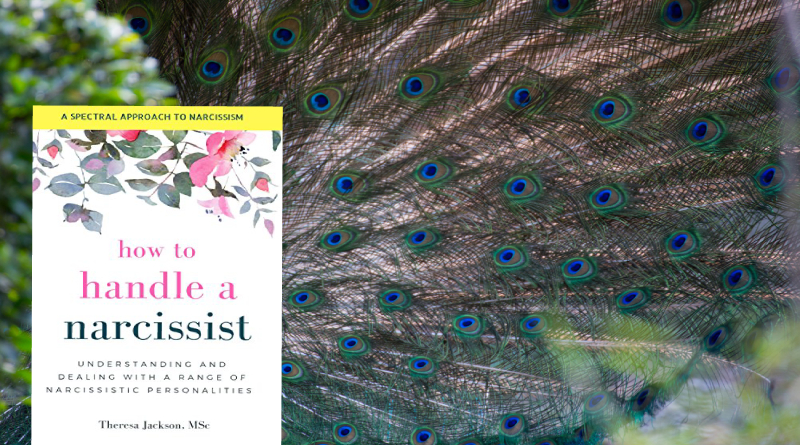See You in the Piazza: New Places to Discover in Italy by Frances Mayes
About The Book:

Bestselling and beloved author Frances Mayes discover the hidden pleasures of Italy in a sumptuous travel narrative that crisscrosses the country, with inventive new recipes celebrating Italian cuisine The Roman Forum, the Leaning Tower, the Piazza San Marco: these are the sights synonymous with Italy. But such landmarks only scratch the surface of this magical country’s offerings.
In See You in the Piazza, Frances Mayes introduces us to Italy only the locals know, as she and her husband, Ed, eat and drink their way through thirteen regions–from Friuli to Sicily. Along the way, she seeks out the cultural and historic gems not found in traditional guidebooks.
Frances conjures the enchantment of the backstreets, the hubbub of the markets, the dreamlike wonder of that space between lunch and dinner when a city cracks open to those who would wander or when a mind is drawn into the pages of a delicious book–and discloses to us the secrets that only someone who is on intimate terms with a place could find.
Amazon Link to purchase Paperback: https://amzn.to/3hspXqE
Amazon Link to purchase Hardcover: https://amzn.to/3E78o9j
Editorial Reviews:
“A sparkling and irresistible view of Italy… Mayes has a wonderful eye for detail as she lyrically describes her surroundings… Readers will want to take their time, savoring this poetic travelogue like a smooth wine.”
—Publishers Weekly(starred)
“Here, we are off the beaten track, soaking in the distinctive sunlight, traditional cuisines, architecture, and geographical features of each area…providing delightful trattoria recipes, poetry, and anecdotes. Readers will definitely eat well by staying by her whimsical and conversational side.”
—Library Journal (starred)
“Mayes has arranged her memoir geographically from north to south, rather than chronologically, to allow readers to peruse the sections randomly, perhaps using the book as a companion guide to their own trip. Her descriptions are painterly and alluring, and she includes recipes for memorable dishes—grilled prawns with fennel and olives, sea bream poached in a special seasoned broth, lemon ricotta tart, gnocchi with a wild hare, and crispy octopus—that are likely to whet the prospective traveler’s appetite. A charming homage to upscale travel through Italy.”
—Kirkus Reviews
About The Author:
FRANCES MAYES Twenty years ago in Under the Tuscan Sun, Frances Mayes introduced readers to a wondrous new world when she bought and restored an abandoned villa in the spectacular Tuscan countryside.
With her signature evocative language and vivid sensory descriptions, she described the beauty and simplicity of life in Italy, inspiring generations to embark on their own journeys–whether that be flying to a foreign country in search of themselves, tasting one of the book’s dozens of delicious seasonal recipes, or simply engaging in the armchair travel for which Frances’s writings are famous.
Now, with a new afterword from the Bard of Tuscany herself, a whole new crop of readers is poised to discover the tastes and passions of Italian living in the 20th-anniversary edition. Frances has always adored houses, and when she saw Bramasole, a neglected, 200-year old Tuscan farmhouse nestled in five overgrown acres, it was love at first sight. Out of that instant infatuation have come three marvelous, and hugely popular, memoirs.
The bestseller Under the Tuscan Sun remained on The New York Times’ bestseller list for two and a half years. The other international bestsellers are Bella Tuscany, and Every Day in Tuscany, the last in her Tuscan trilogy. She has published two photo texts, In Tuscany, a collaborative photo textbook with her husband, the poet Edward Mayes and photographer Bob Krist, and Bringing Tuscany Home:
Sensuous Style from the Heart of Italy, another collaborative book with Edward Mayes and photographer Steven Rothfeld. All five highly personal books are about taking chances, living in Italy, loving and renovating an old Italian villa, the pleasures of food, wine, gardens, and the “voluptuousness of Italian life.”
The books are translated into more than forty languages. Recently, Frances and Ed published The Tuscan Sun Cookbook: Recipes from My Italian Kitchen, a collection of their favorite Tuscan recipes. Under Magnolia: A Southern Memoir, published in April 2014 by Crown, is Frances Mayes’s coming-of-age in Georgia memoir. The story begins and ends in the present, with the middle of the book devoted to life in the deepest South in a small town.
It’s an ode to the South as an intense and (then) isolated place and to the people who lived their passionate lives there. The book is populated with a cast of intrinsically southern characters—fatalistic, ribald, eccentric, and big-hearted. Her first novel, Swan, a family saga and mystery, returns Mayes to her childhood home in Georgia. A film version of Under the Tuscan Sun, starring Diane Lane, was released in the fall of 2003.
She is also the author of the travel memoir entitled A Year in the World: Journeys of A Passionate Traveller, which immediately debuted as a New York Times bestseller in 2006. Working again with Steven Rothfeld, she published Shrines: Images of Italian Worship. A widely published poet and essayist, Frances Mayes has written numerous books of poetry, including Sunday in Another Country, After Such Pleasures, The Arts of Fire, Hours, The Book of Summer, and Ex Voto.
Her text The Discovery of Poetry: A Field Guide to Reading and Writing Poems is widely used in college poetry classes. Formerly a professor of creative writing at San Francisco State University, where she directed The Poetry Center and chaired the Department of Creative Writing, Mayes now devotes herself full time to writing. She and her husband divide their time between North Carolina and Tuscany.
Review:
Appearance:
Content:
Did You Know: (Book Articles)
-
Chapter 1
Torino
The waiter slides toward me a clear little glass layered with cream, chocolate, and coffee. Sip the layers and you taste Torino. The bicerin—dialect for small glass—has come to be synonymous with the many atmospheric cafés that are the city’s lifeblood. Torino is flush with regal boulevards and piazzas ringed with these delicious haunts. I’m at the wood-paneled Caffè Al Bicerin, intimate, with candles on tiny marble tables. In this very place, someone in 1763 first concocted the bicerin, a wickedly sumptuous drink. I like a place that remembers a coffee drink invented 256 years ago.
I’ve slipped into other historic cafés to sample their bicerin or lemonade or cappuccino. Bliss. There’s Caffè Torino under the grand arcades, where the great Cesare Pavese, who lived nearby, used to meet other writers; Caffè Mulassano, with a marble bar and bentwood chairs, said to have the best espresso in town. Baratti e Milano, more chocolate- and confection-oriented than the others but with an old-world air, and Caffè San Carlo, all gilt and columns and statues.
In the late afternoon, the cafés serve aperitivi. No surprise: Campari and vermouths such as Punt e Mes were all invented in Torino. Order a drink and you’re welcome to a lavish buffet of stuzzichini—crostini, olives, chips, focaccia, prosciutto, slices of omelet, and grissini, breadsticks (also invented in Torino). This interlude previews dinner. Which is glorious to anticipate. Torino restaurants are up there with the best in Italy.
Late morning, Ed and William, who’ve been out walking, meet me under the arcades at Caffè Torino. They are impressed by its bodacious chandeliers, smooth waitstaff, and medallion of a rampant bull inlaid in the flagstones outside the door. This is a perfect perch for watching the human parade. We ordered a cappuccino, then tramezzini, the triangular half sandwiches made of trimmed, soft white bread—the kind of air bread we usually scorn. “These were invented in Torino,” I tell them. “At Caffè Mulassano. The weird poet D’Annunzio made up the name . . .” Mine is ham and cheese.
“Tramezzo, a divider. Across the middle,” Ed says. “The -ino or -ini is the diminutive.”
“Across the middle of the morning or across the corners of the bread?” William asks.
“Who knows? It was easier to say than the popular ‘English tea sandwich.’’’
“Everything was invented in Torino?” William concludes.
Unlike panini, the tramezzini usually have mayonnaise. Almost all bars, train stations, and cafés serve a variety. Ed took to them right away, especially the tuna and olive for a mid-morning snack.
Spread out on the table, our books on Piemonte and the poems of Pavese. Never much of a café sitter, I could while away the morning like this. A well-dressed businessman grinds his foot over the balls of the gold bull. Not sure how that brings the good luck it’s reputed to.
We stroll along Via Garibaldi and Via Roma, checking out the designer shops (oh, no! William is attracted to Louis Vuitton belts). Torino has eighteen kilometers of covered walkways, a reminder that inclement weather can pour in from the Alps. The chic shops are punctuated by more appealing cafés in glass-roofed Galleria San Federico, where we happen upon Cinema Lux, an Art Nouveau theater. In smaller streets, we find Libreria Internazionale Luxemburg, a vintage British bookstore and a cool contemporary café and art space.
Where are the tourists? we wonder. They’re all in Florence. We came to Torino last summer with William and loved every minute of the four days we spent blessedly free from mobs. We all agreed—we needed more time here. As we begin a trip into Piemonte, we decided to light here again.
What a fantastic place to bring a child or young adult! Highlights from our first visit:
We took a taxi out to the Museo Nazionale dell’Automobile. Even if you’re not a car fan, you have to swoon at the design genius on display. The emphasis is on vintage Fiat, Lancia, and Alfa Romeo, though there are Bugattis, Ferraris, and others. A long-time Alfista (one who adores Alfas), Ed examined each.
Eataly: the Italian food emporium near the car museum. We walked from the car museum to there for lunch and to look at the amazing range of olive oil, pasta, honey, jam, wine, and other products, all from this country.
Museo Egizio: after Cairo, the largest Egyptian museum in the world. Torino began collecting in 1630, and now displays 6,500 items (with another 26,000 in storage). The museum is located right in the Centro.
Museo Nazionale del Cinema in the Mole Antonelliana, where on the ground floor, you can watch movie clips in lounge chairs with headphones. You spiral up to three floors of changing displays; many are interactive, demonstrating the history of photography and film. It’s a lively tour. The glass-walled elevator takes you to the tower for a view over Torino and the Alps in the distance. I didn’t go; it looked claustrophobic and harrowing. Ed and William did, and they reported it was claustrophobic and harrowing.
Via Po: Stroll along this grand boulevard lined with palazzi and arrive at the Po River. The rarefied French influence of the House of Savoy, which ruled Italy from 1861 to 1946, is everywhere in Torino. A gaily lit string of cafés beckons as evening falls. A moment to time-travel to nineteenth-century Paris.
We are staying at the home of Pavese! By chance, I came across a listing for a B & B called La Luna e i Falò (The Moon and the Bonfires is the title of one of Pavese’s novels). I was shocked to see that the B & B had been his home. With awe, I reserved two of its three rooms. His own copies of his paperbacks lie on the hall table. His small writing room (or was it his dining room?) is now the guests’ sitting room. Our bedroom, furnished with antiques, blue toile fabrics, a table in front of a window, looks out at the graceful balconies that festoon the elegant houses across the street.
I open the window and look at what Pavese looked at. Where he smoked and smoked, and wrote and wrote. Where he sipped Campari and left his slippers by the chair. The current dining room, where we’re served afternoon tea and breakfast at round tables with flowers and silver, must have been his living room. There would have been books and paintings. If he appeared today, what would he think? Yes, the young woman who checked us in says, yes, he lived here in 1950 when he committed suicide. “Not at home,” she adds quickly. “He locked this door for the last time and checked into Hotel Roma near the train station. Overdose of sleeping pills. He was two weeks shy of forty-two.”
All that passion and romance and darkness and profundity and work silenced by a handful of pills. There’s an undercurrent of loss running through his poems but a swifter stream of longing and acute love for people. I tried this translation of his poem, “La Casa”:
The House
The man alone listens to the calm voice
with eyes half-closed, almost a breath
blowing on the face, a friendly breath
that rises, incredibly, from a time gone.
The man alone listens to the ancient voice
that his fathers, in their time, have heard, clear
and absorbed, a voice that like the green
of the ponds and the hills darkens at evening.
The man alone knows a shadow voice,
caressing, that rises in the calm tones
of a secret spring: he drinks it attentively,
eyes closed, and it doesn’t seem past.
And the voice that one day stopped the father
of his father, and every one of dead blood.
A woman’s voice that sings secretly
At the threshold of the house, to the falling dark.
I like his poem. He is trying to express something that cannot really be said. Translating feels like pouring water through a sieve. Two lines don’t go happily into English. Perhaps aren’t that happy in Italian, either. That’s okay. Pavese has pulled me into an intensely private moment. A woman sings. The song has been heard by his father and his father’s father before. The threshold—now and then, life and death, love and loss. The song spirals in his DNA. A lullaby, a love song, a dirge.
I like his house, too. There’s a squeak to a floorboard, a panel of sunlight falling in at an angle, a gray quietness where something might happen. And it did. Beginning with Walt Whitman, he worked vigorously on translations, in addition to his own novels and poetry. Moby-Dick! From this small room, he brought contemporary American fiction to Italy: Sinclair Lewis, John Dos Passos, Sherwood Anderson, William Faulkner, Gertrude Stein. Nights of work. Then he would take long walks in the rain.
At lunch, we stop at Pepino on Piazza Carignano and sit outside for quick vegetable salads. William notices an old, wheeled ice cream cart parked near the door and people at the next table ordering what we called “nuggets” when I was growing up. We find out that the Pinguino, penguin, the original chocolate-dipped ice cream on a stick, was invented here in 1939. Pepino has been making gelato since 1884. “That list of Torino inventions is getting longer,” William remarks. I think for years invented in Torino will be a family saying.
All of Piemonte is known for the pleasures of the table but Torino particularly so. Those Savoy royals brought from France the tradition of fabulous desserts, not always, or even usually, a given in Italy (except for gelato). The wine region just to the north, the irresistible cheeses, the ever-present taste of hazelnut, the coveted beef of Piemontese Fassone cows, and sopratutto, above all—chocolate. Not only plain chocolate but gianduia, chocolate with roasted hazelnuts, one of those genius mother-of-necessity inventions at a time when chocolate was scarce and roasted hazelnuts were incorporated to stretch the quantity. Gianduia probably was named after a commedia dell’arte character. A foil-wrapped gianduia in the shape of Gianduia’s hat is called giannuiotto. The plump triangles melt in your mouth and on your fingers.
Several superb chocolate makers reign in Torino. Our good friends in Tuscany, Aurora, and Fulvio grew up here. With the gift of a lavish box that could have held a limited-edition art book, they introduced us to Guido Gobino chocolates. Last year, we visited the jewel-box shop via Giuseppe Luigi Lagrange, 1. Now, we retrace those steps. Gianduia, check fruit gelatine (jellies), check. Also, the jellies of pear, lemon, myrtle are covered with milk chocolate. But this time we go for the ganache, flavored with Barolo, candied lemon, orange and almond, lemon and cloves, vermouth. William selects our box for the road. After being offered several delectable tastes, we can’t even try a chocolate granita or a cold summer bicerin.
I so want to write about food! Where to begin? I could write an entire book about Torino. We were wild about every restaurant we tried on our trip last year, beginning with the classic Tre Galline and the inventive bio-aware Consorzio. Before the Savoys entered with their fancy ways, Torinese was feasting on goose, rabbit, venison, boar, snails, goat, and—oh, yes—donkey. Never scorned: il Quanto quarto, the fifth part, meaning offal. Modern chefs are still inventing around these ingredients, which endure in temples of gastronomy dusted with Michelin stars.
We each had our favorite restaurants. Mine was:
Del Cambio. The long mirrors sending back the sparkle of chandeliers, the tables, drawn up to claret velvet banquettes and laden with polished cutlery and hothouse flowers, the atmosphere of friendly hauteur. I wished I’d worn a black dress and very high heels, but the printed silk shirt and linen pants had to do. I imagined all the occasions that Torinesi families have celebrated here.
Since 1757, Del Cambio has served the locally beloved finanziera, a stew our friend Fulvio always raves about anytime he returns to Torino for a visit. The hallowed dish earned its name from what was on the backs of bankers who dined at this very restaurant; they wore coats called finanziere, financiers. The recipe is sometimes called finanziera Cavour, for the prime minister–statesman who frequented the restaurant. The ingredients include brains and veins, veal, bone marrow, calf and/or rooster testicles, cockscomb, wattle, mushrooms, Marsala or Barolo, parsley, garlic, and bay leaves. Finanziera’s popularity in Torino reveals something essential about the local palate: anything that moves or grows is fair game. Were we brave enough to try this signature dish?
I’m afraid, in summer, we tended toward lighter fare. Pretty shapes of melon on ice, gossamer fried slices of vegetables; plin (pinched ravioli) with lardo, lemon, and mackerel; vitello tonnato (a Piemontese favorite, veal with a creamy tuna sauce); sea bass in sea lettuce. William is served a small amount of wine. He wore a fitted gray sport coat and white shirt. He was wide-eyed with pleasure. I had a glimpse of the man he will be, someday sitting with someone he loves.
Service is cordial. If you get up from the table, the waiter doesn’t just refold your napkin. He brings a fresh one. This lighting makes everyone look glamorous. I’m intrigued by a bejeweled older woman next to us (an aged-out high-class prostitute?), sitting beside her ancient, coiffed, and silent mother. There’s a story there, as there’s a story everywhere.
Dessert arrived. A gianduia expanse topped with blackberries and, on top of William’s, a chocolate model of the Mole Antonelliana, the tower he ascended. The tower is toppled and we all had a bite.
Ed’s favorite: Circolo dei Lettori, formerly a private literary club that now hosts publishing events and book clubs in their reading room, but also serves lunch and dinner in hushed, clubby rooms lined with paintings of artists. What a special lunch, watched by the faces of Torino’s artists.
William’s favorite, and a topic of conversation all year: Combal.Zero, a long taxi ride outside town to Rivoli, one of the royal palaces, and now Museo d’Arte Contemporanea. By the time we arrived, the museum was long closed. We had to ring at a gate, where a hip-looking guy escorted us to the long, glass-walled restaurant of chef Davide Scabin. Only two other tables were occupied. (This really is too far from town for a spontaneous visit.) William was immediately stunned when they presented a water menu, listing an array from all over Europe with their mineral contents. He and Ed proceeded with the extravagant tasting menu, far too experimental for my tame palate. Ed selected the wine pairings and William was offered pairings as well, various fruit, water, and tea preparations. The courses began to roll out. This, clearly, is play. The chef is having fun. We had fun, too. The waiters hovered, enjoying William’s awe and delight. It’s a party.
Torino: Forty museums. Sixty markets. Churches, more cafés, contemporary galleries—we must come back. Again, and again. We cannot, we agree, leave without visiting the Musei Reali complex, the residences and collections of the Savoy rulers, and the gardens designed by André Le Nôtre. The scale of the city complex is daunting. We tour the royals’ personal quarters, which are so gilded and frescoed and sumptuous that we emerge feeling that we must be gold-leafed ourselves. I like the neoclassical ballroom best—the gold rosettes on the coffered ceiling with allegorical dancers representing Time frolicking around Apollo and the Muses. The Armeria, a grand room of armorial dress, is surprisingly interesting because the heavy plates often are decorated or personalized. Fashion was as important as protection.
I always write my reviews on Amazon, 3ee, Goodreads, LibraryThing, and Social Media such as Facebook, Instagram, Twitter, Linked In, Telegram, and Google+.
If you also have read this book, please share your review below, we greatly appreciate your comment, and let’s talk about it!



